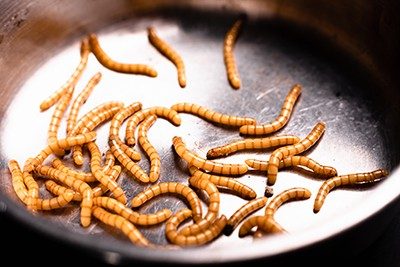FOR IMMEDIATE RELEASE | August 24, 2022
Cooking up mealworms into a tasty, healthful, ‘meat-like’ seasoning
CHICAGO, Aug. 24, 2022 — Beetle larvae, such as mealworms, are often considered to be creepy, crawly nuisances. But these insects are edible and could be a healthful alternative to traditional meat protein sources. Today, researchers report that they’ve cooked up mealworms with sugar, creating a “meat-like” flavoring. It could someday be used in convenience foods as a tasty source of extra protein.
The researchers will present their results today at the fall meeting of the American Chemical Society (ACS). ACS Fall 2022 is a hybrid meeting being held virtually and in-person Aug. 21–25, with on-demand access available Aug. 26–Sept. 9. The meeting features nearly 11,000 presentations on a wide range of science topics.
“Recently, eating insects has become of interest because of the increasing cost of animal protein, as well as the associated environmental issues,” says In Hee Cho, Ph.D., the project’s principal investigator.
The global population is expected to reach 9.7 billion people by 2050 and nearly 11 billion by 2100, according to the United Nations. And feeding them all with animal meat — especially cows, pigs and sheep — will require larger amounts of food, water and land resources. In addition, cows are a substantial contributor to climate change, releasing copious amounts of methane in their burps. So, more sustainable sources of protein are needed.
“Insects are a nutritious and healthy food source with high amounts of fatty acids, vitamins, minerals, fiber and high-quality protein, which is like that of meat,” says Cho, whose team is at Wonkwang University (South Korea).
But mealworms suffer from an image problem, she says.
In many parts of the world, eating insects isn’t common, and people can be squeamish about munching on them. Although some companies are trying to change people’s minds by selling cooked whole mealworms as crunchy, salty snacks, consumer acceptance is not widespread. Cho says that to get more people to regularly eat mealworms, a sneakier approach might be in order — hiding insects in the form of seasonings inside easy-to-cook and other convenience products.
The research team’s first step was to understand this insect’s flavor profile. They compared mealworm aromas throughout its lifecycle, from egg to larva to pupa to adult. While there were some differences in the individual compounds, all of the stages primarily contained volatile hydrocarbons, which evaporate and give off scents. For example, raw larvae had wet soil-like, shrimp-like and sweet corn-like aromas.
Then Hojun Seo, a graduate student on Cho’s team, compared the flavors that developed as larvae were cooked with different methods. Steamed mealworms developed even stronger sweet corn-like aromas, whereas roasted and deep-fried versions had shrimp-like and fried oil-like attributes. According to Seo, the flavor compounds from roasting and frying included pyrazines, alcohols and aldehydes, and were similar to the compounds formed when meat and seafood are cooked.
Based on these results, the team expected that additional reaction flavors could be produced from the protein-rich mealworms if they were heated with sugar. Reaction flavors, sometimes called process flavors, are produced when proteins and sugars are heated together and interact, for instance, through Maillard, Strecker and caramelization reactions and fatty acid oxidation, says Cho. The result is usually a suite of “meat-like” and savory flavors.
Hyeyoung Park, a graduate student in Cho’s lab and the presenter at the meeting, tested different manufacturing conditions and ratios of powdered mealworm and sugars, producing multiple versions of reaction flavors. She identified a total of 98 volatile compounds in the samples. The team then took the samples to a panel of volunteers to provide feedback about which had the most favorable “meat-like” odor. “As a result of this study, 10 of the reaction flavors were optimized based on consumer preferences,” says Park.
To the best of the researchers’ knowledge, this is the first time that mealworms have been used to produce desirable reaction flavors. They hope that these results will contribute to the commercial development of meat-like and savory flavorings and seasonings, and will encourage the convenience food industry to include edible insects in their products, says Cho. The team’s next step is to further optimize cooking processes to reduce any potentially undesirable or off-flavors in the final flavoring material made from mealworms.
The researchers acknowledge support from the Rural Development Administration (South Korea) and Wonkwang University (South Korea).
A recorded media briefing on this topic will be posted Wednesday, Aug. 24, by 10 a.m. Eastern time at www.acs.org/acsfall2022briefings.
ACS Fall 2022 will be a vaccination-required and mask-recommended event for all attendees, exhibitors, vendors and ACS staff who plan to participate in-person in Chicago. For detailed information about the requirement and all ACS safety measures, please visit the ACS website.
To automatically receive press releases from the American Chemical Society, contact newsroom@acs.org.
Note: ACS does not conduct research, but publishes and publicizes peer-reviewed scientific studies.
Media Contact
ACS Newsroom
newsroom@acs.org


